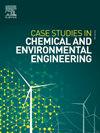PFAS Contamination and Mitigation: A Comprehensive Analysis of Research Trends and Global Contributions
Q1 Environmental Science
Case Studies in Chemical and Environmental Engineering
Pub Date : 2025-01-31
DOI:10.1016/j.cscee.2025.101127
引用次数: 0
Abstract
Per
and polyfluoroalkyl substances (PFAS) are a group of synthetic chemicals known for their persistence in the environment and potential adverse effects on human health. This study conducted a bibliometric analysis of 581 publications from the Scopus database, covering the period from 2015 to November 2024, to assess research trends and developments related to PFAS. The findings reveal a significant increase in research output, with the number of published articles rising from just 7 in 2015 to 134 in 2024, indicating a growing global awareness of PFAS contamination. "Environmental Science" emerges as the leading discipline, accounting for 44.8% of total publications, followed by Chemistry at 15%. The United States is the foremost contributor, with 216 publications and 11,213 citations, followed by China and Sweden. Common PFAS compounds, particularly perfluorooctanoic acid (PFOA) and perfluorooctane sulfonic acid (PFOS), have been widely detected in various ecosystems, including surface water, groundwater, and soil. These substances pose significant risks to aquatic organisms and human health due to their persistence and potential for bioaccumulation. The analysis highlights effective treatment methods for PFAS removal, such as adsorption and photocatalysis, which are crucial for mitigating environmental contamination. Prominent journals like "Science of the Total Environment" and "Environmental Science and Technology" play vital roles in disseminating research findings, while the "National Natural Science Foundation" of China is identified as a key funding source supporting numerous studies. Overall, the research underscores the need for innovative strategies and integrated management plans to combat PFAS pollution effectively. It emphasizes the importance of interdisciplinary collaboration to enhance understanding of PFAS behavior in ecosystems and to develop effective remediation techniques, ultimately protecting water quality and public health from the multifaceted challenges posed by PFAS contamination.

PFAS污染与缓解:研究趋势和全球贡献的综合分析
Perand polyfluoroalkyl substances (PFAS)是一组合成化学品,因其在环境中的持久性和对人类健康的潜在不利影响而闻名。本研究对Scopus数据库2015年至2024年11月的581篇文献进行了计量分析,以评估与PFAS相关的研究趋势和发展。研究结果显示,研究产出显著增加,发表的文章数量从2015年的7篇增加到2024年的134篇,表明全球对PFAS污染的认识日益提高。“环境科学”成为领先的学科,占总出版物的44.8%,其次是化学,占15%。美国是最大的贡献者,发表了216篇论文,引用了11213次,其次是中国和瑞典。常见的全氟辛烷化合物,特别是全氟辛酸(PFOA)和全氟辛烷磺酸(PFOS),已在各种生态系统中广泛检测到,包括地表水、地下水和土壤。这些物质由于其持久性和潜在的生物蓄积性,对水生生物和人类健康构成重大风险。分析强调了去除PFAS的有效处理方法,如吸附和光催化,这对减轻环境污染至关重要。《全环境科学》、《环境科学与技术》等知名期刊在传播研究成果方面发挥着重要作用,而“国家自然科学基金”被确定为支持众多研究的重要资金来源。总体而言,该研究强调需要创新战略和综合管理计划来有效地对抗PFAS污染。它强调跨学科合作的重要性,以加强对PFAS在生态系统中的行为的理解,并开发有效的补救技术,最终保护水质和公众健康免受PFAS污染带来的多方面挑战。
本文章由计算机程序翻译,如有差异,请以英文原文为准。
求助全文
约1分钟内获得全文
求助全文
来源期刊

Case Studies in Chemical and Environmental Engineering
Engineering-Engineering (miscellaneous)
CiteScore
9.20
自引率
0.00%
发文量
103
审稿时长
40 days
 求助内容:
求助内容: 应助结果提醒方式:
应助结果提醒方式:


